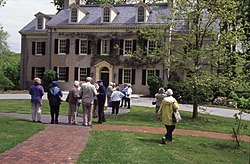Hagley Museum
|
Hagley Museum and Library
|
|
 |
|
| Nearest city | Wilmington, Delaware |
|---|---|
| Coordinates | 39°46′50″N 75°34′30″W / 39.78056°N 75.57500°WCoordinates: 39°46′50″N 75°34′30″W / 39.78056°N 75.57500°W |
| Area | 235 acres (95 ha) |
| Built | beginning 1802 |
| NRHP Reference # | 84000819 |
| Significant dates | |
| Opened | 1957 |
| Added to NRHP | November 13, 1966 |
The Hagley Museum and Library is a nonprofit educational institution in Wilmington, Delaware. Covering more than 235 acres (0.95 km²) along the banks of the Brandywine Creek, the museum and grounds include the first du Pont family home and garden in the United States, the powder yards, and a 19th-century machine shop. On the hillside below the mansion lies a Renaissance-revival garden, with terraces and statuary, created in the 1920s by Louise Evalina du Pont Crowninshield (1877–1958). The facility sits at the midpoint of the DuPont Historic Corridor.
Opened in 1957, the Hagley Museum features exhibits and demonstrations that show the connections between early industrial technology and early American history, focusing on the histories of the du Pont family, DuPont company, explosives and gunpowder, and innovation (through a large collection of American Patent models). The Museum also explores personal stories of the 19th-century DuPont Company employees, how they lived, and how their lifestyles changed along with new machinery and new production methods.
Hagley's library houses a major research collection of manuscripts, archives, photographs, pamphlets, and books documenting the history of American business and technology. A member of the Independent Research Libraries Association, the library serves scholars from this country and abroad. Holdings include 37,000 linear feet in the Manuscripts and Archives Department, 290,000 printed volumes in the Imprints Department, 2 million visual items in the Pictorial Department, and more than 300,000 digital images and pages in the Digital Archives Department. The library and archival collections owned by Hagley are open to the public for research; a catalog and partial digital archive are available online.
The library includes Hagley's intellectual heart: the Center for the History of Business, Technology, and Society, which coordinates Hagley's interactions with the world of scholarship in the fields of American economic, business, and technological history. The center offers a scholar-in-residence program and competitive fellowships, and organizes seminars and historical conferences.
In 1802, French immigrant Eleuthère Irénée du Pont founded black powder mills on the banks of Brandywine Creek. He chose the location for the river's tumble over the fall line which provided power, timber and willow trees (used to produce quality charcoal required for superior black powder), the proximity to the Delaware River (on which other ingredients of the powder – sulfur and saltpeter – could be shipped); and the quarries of gneiss which would provide building materials for the mills. The E. I. du Pont de Nemours & Company's black powder factory became the largest in the world.
...
Wikipedia


